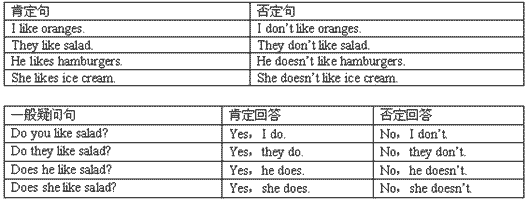按要求对下列句子进行转换,每空一词。1. Thebabylikesloudtalking. (变成否定句) Thebaby________loudtalking.2. Dannyislookingatthedumplings. (对划线部分提问)isD-五年级英语
题文
| 按要求对下列句子进行转换,每空一词。 |
| 1. The baby likes loud talking. (变成否定句) The baby________loud talking. 2. Danny is looking at the dumplings. (对划线部分提问) is Danny ? 3. Jenny sees a tall green tree. (改为一般疑问句) Jenny a tall green tree? 4. Would you like some milk to drink? (作否定回答) , . 5. Danny is looking out of the window.(变成否定句) Danny looking out of the window. |
答案
| 1. doesn't, like 2. What, looking, at 3. Does, see 4. No, thanks 5. isn't |
据专家权威分析,试题“按要求对下列句子进行转换,每空一词。1. Thebabylikesloudtalk..”主要考查你对 一般现在时,动词单数第三人称,疑问代词,系动词,现在进行时,现在分词,一般疑问句 等考点的理解。关于这些考点的“档案”如下:
一般现在时,动词单数第三人称疑问代词系动词现在进行时,现在分词一般疑问句
考点名称:一般现在时,动词单数第三人称
一般现在时:
表示现在经常反复发生的动作、存在的状态或习惯性的动作的时态。可概括为
①经常性或习惯性动作;
②长期存在的特征或状态;
③普遍真理、客观事实等。
构成:
一般现在时用行为动词的原形,但第三人称单数作主语时,动词的词尾要加-S。
a. 表示经常性或习惯性的动作。
例:Li Ming always helps the old man. 李明一直帮助这位老人。
We usually go to school on foot. 我们通常步行上学。
They sometimes go fishing on Sundays. 他们有时周日去钓鱼。
b. 表示永恒不变的事实或真理。
例:A bird flies with wings. 鸟用翅膀飞翔。
c. 用在格言、谚语中。
例:Pride goes before a fall. 骄者必败。- 一般现在时具体用法:
1.表示经常的或习惯性的动作,常与表示频率的时间状语连用。
时间状语:
always,usually,every morning/night/evening/day/week/year,often,sometimes,
occasionally,from time to time,twice a week,rarely,seldom,once a month,hardly,ever,never.
e.g: I leave home for school at 7:00 every morning.
2.表示主语具备的性格、能力、特征和状态。
e.g:I don't want so much.
Ann Wang writes good English but does not speak well.
比较:Now I put the sugar in the cup.
I am doing my homework now.
3.表示客观事实和普遍真理。
e.g :The earth moves around the sun.
Shanghai lives in the east of China.
4.在时间状语从句和条件状语从句中,常用一般现在时代替将来时。
5.表示预先计划或安排好的行为。
6.小说故事用一般现在时代替一般过去时。新闻报道类的内容,为了体现其“新鲜”性,也用一般现在时来表示过去发生的事情。
7.有些表示状态和感觉的动词表示现在发生的具体行为时,只用一般现在时,而不用进行时态。
8.表示现在发生的具体动作或存在的状态
9表示格言或警句中。 e.g Pride goes before a fall. 骄者必败。
注意:此用法如果出现在宾语从句中,即使主句是过去时,从句谓语也要用一般现在时。
例:Columbus proved that the earth is round..
第一句用一般现在时,用于操作演示或指导说明的示范性动作,表示言行的瞬间动作。
再如:Now watch me,I switch on the current and stand back.
第二句中的now是进行时的标志,表示正在进行的动作的客观状况,所以后句用一般现在时。 - 一般现在时用法表:

第三人称单数的构成见下表:
不规则变化have和be动词 变have为has 变be为am,is,are例: have-has; be-am,is,are词
构成
举例
一般情况
词尾+s
动词原形
第三人称单数
work(工作)
stop(停止)works
stops以-ch, -sh, s, x, o结尾
词尾+es
teach(教)
wash(洗)
dress(装扮)
fix(安装)
go(去)teaches
washes
dresses
fixes
goes以“辅音字母+y”结尾
变y为i,再加es
fly(飞翔)
try(尝试)flies
tries 一般现在时的特殊用法:
一些动词可用一般现在时来表达现在进行时:
verbs of the senses: hear,see,taste,smell,feel
verbs of the thinking: believe,know,mean,realize,think,remember
verbs of the linking: dislike,fear,heat,like,love,want
verbs of the possession: belong,have,own,possess
考点名称:疑问代词
- 疑问代词:
在句子中用来构成特殊疑问句,主要用于询问“何人”、“何事”、“什么”。
常见的疑问代词如下表所示:

![Danny apairofskates.[ ]A.hasB. haveC. is-六年级英语](http://www.00-edu.com/d/file/ks/4/1/47/2019-08-24/smallfac5032aba6ffd5133224fbfd6f627641566585773.png)
![I have a telescope; my sister _____ one, too. [ ]A. have B. /C. has-六年级英语](http://www.00-edu.com/d/file/ks/4/1/47/2019-08-24/small95b931d9eba0d6e0d51fcb17c976b6ab1566587233.png)
![Mysister_________ tea.[ ]A.doB.makeC.makes-二年级英语](http://www.00-edu.com/d/file/ks/4/1/47/2019-08-24/smalld9c80030fe676239effad1766f1ca9c91566585454.png)
![John _____________ a stamp for his letter. [ ]A. needB. needsC. needing-五年级英语](http://www.00-edu.com/d/file/ks/4/1/47/2019-08-24/smallcebb0f01dc82000e4d9f8a50418bc5e51566586956.png)
![It'sred.It __________ abandageonit![ ]A. have B. has-五年级英语](http://www.00-edu.com/d/file/ks/4/1/47/2019-08-24/smallcf3a20012c2087fbeb76d9ac03e80fe91566585957.jpg)
